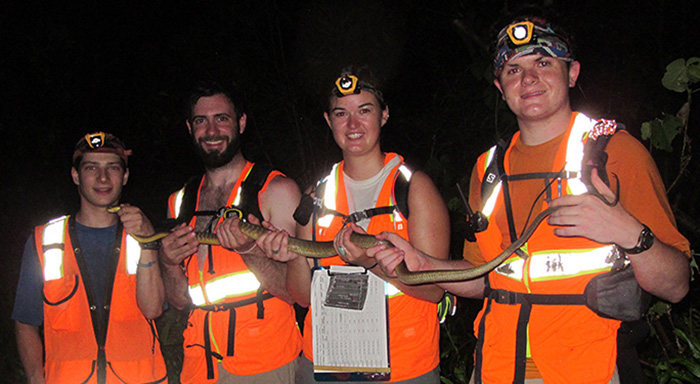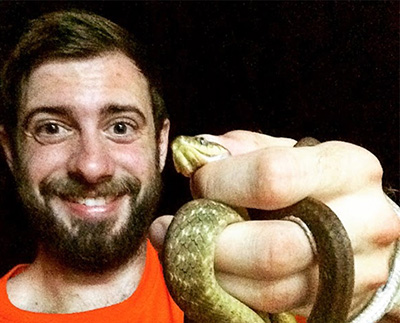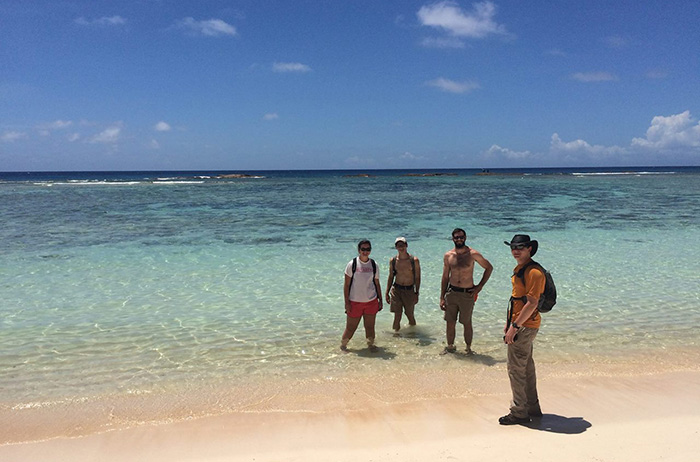Night Trackers

From left: Max Rubinstein ‘16, John Capano ’13, Elizabeth Schultz ’15, and Andrew Veselka ’15.
Student-alumni research team tracks snakes by night in Guam
by MaryAlice Bitts-Jackson
They stowed away on U.S. military ships from the South Pacific just after World War II, and in the six decades since reaching shore, they’ve silently infiltrated nearly every aspect of day-to-day life. We’re talking brown tree snakes, said to be one of the most successful invasive species, with approximately 1,300,000 slithering across the 30-mile-long island of Guam.
More than simply power-cord-gnawing, home-infesting nuisances, the nocturnal snakes have caused the extinction of many of Guam’s native vertebrates, including 10 species of birds. And with exploding populations of snakes in the forests and vegetation skirting shorelines and surrounding the island’s Andersen Air Force Base, the possibility of stowaway snakes traveling by boat or plane to Hawaii and other Pacific islands—and then taking over those ecosystems—is very real.
This summer, students and former students of Associate Professor of Biology Scott Boback are investigating how best to combat that possible Snakes on a Plane scenario by taking part in a research project funded by the U.S. Department of Defense and led by the U.S. Geological Survey (USGS). The idea is to refine the USGS’s current snake-sleuthing techniques, using high-tech devices to track the snakes’ movements, night to night, so they can better predict future behavior.
Circling in

John Capano '13 poses with one of the brown tree snakes.
For four nights each week, John Capano ’13, Andrew Veselka ’15, Elizabeth Schultz ’15 and Max Rubinstein '16 use radio frequencies to track 21 snakes that were previously implanted with radio transmitters and live in the Andersen Air Force Base’s Habitat Management Unit. Because the 136-acre study area is surrounded by a snake-proof fence and the snake population within the unit has been reduced with an environmentally safe toxicant, it offers a unique chance to observe how the snakes behave in low population densities. This can help scientists better find brown tree snakes after possible introduction on other islands, but before the population explodes to Guam-like levels.
Beginning at about a half-hour after sundown, two of the Dickinsonians travel north, and two, south, walking transects or bushwhacking their way toward their specimens. As a subteam gets close to a snake, the two team members split up and surround the presumed location to reduce angles of attack. When the target is confirmed they circle around it, gradually zeroing in until they see the snake and make a note of its GPS location. Then it’s off to the next specimen, until all have been found—usually by around midnight.
“Some of the snakes are easy to track because they don't move a whole lot, but there are a couple that like to move fairly far distances,” says Schultz—who co-researched boa constrictors with Boback while at Dickinson and plans to pursue a career in medicine—noting that the team already has discovered some of the snakes’ favorite spots. “When we see them in the trees and even on the ground, we've seen that they have amazing cantilever ability—it’s really easy to see why they have been so successful here.”
While the Dickinsonians use radio transmitters to track the snakes, a team of USGS biologists performs visual surveys along the same patch of woods.
“The overarching goal is to help create more effective detection methods for the snakes by comparing the two datasets and seeing if the snakes are located where the visual teams can find them,” says Capano, the Dickinson research crew leader, who completed a senior research project with Boback on the biomechanics of ventilation in the boa constrictor, and will pursue a Ph.D. in ecology and evolutionary biology at Brown University, beginning in August. “If visual teams are consistently missing snakes that the radio tracking crew is finding on their nightly paths, new detection methods can be developed.”
Dashing up that curve
As the summer continues, the Dickinson research team will work inside the Guam National Wildlife Refuge on two projects that it has independently developed. They will study the invasive cane toad on Guam, noting the differences in movement distance versus displacement to help determine home ranges and facilitate land management with possible control measures. They also will use bait stations and camera traps to estimate feral hog densities within the refuge.
All signs point to a successful run, says the USGS’s Robert Reed, who heads the brown tree snake project, and brought on Boback, an expert in snake ecology, to help refine the ideas that led to the current work.

“Even though these Dickinson [researchers] didn't have a whole lot of snake research experience or tropical island research experience, and their learning curve was steep, they’re sharp and motivated, and they picked things up very, very quickly,” he says. “They’re flexible and adaptable, and we’re very pleased with their work.”
The researchers are likewise thrilled, says Rubinstein, a biochemistry & molecular biology major who took Boback’s First-Year Seminar in 2012. “I’ve always loved snakes, and the chance to spend my summer outdoors is pretty incredible,” he says.
Learn more
Published June 18, 2015